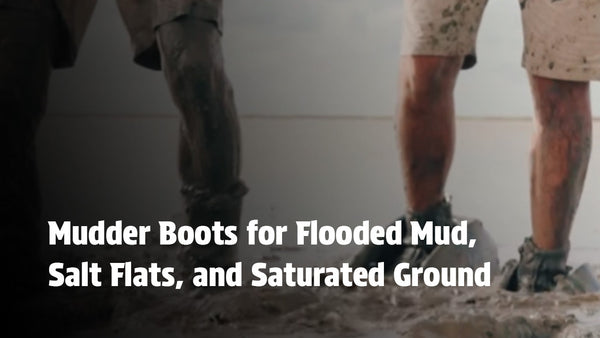
How Does Flooded Mud, Salt Flats, and Saturated Ground Occur?
Understanding the formation of flooded mud, salt flats, and saturated ground means diving into the intersection of geology, hydrology, and climate. These landforms are more than just barren or soggy stretches of earth; they are the result of specific environmental conditions that shape the ground beneath our feet in dramatic ways.
Key Takeaways
- Flooded Mud: Excessive water in clay-rich soil; poor drainage; common in floodplains and construction sites.
- Salt Flats: Desert landforms created by evaporation cycles; rich in minerals; crust is deceptive and soft underneath.
- Saturated Ground: Waterlogged soil; high risk for landslides and crop damage; common in areas with impermeable sublayers.
- Mudder Boots: Designed for extreme terrain; offer floatation over soft surfaces; secure with buckles and evacuate debris efficiently.
Let’s explore how each of these natural phenomena occurs and what makes them distinct.
Flooded Mud
Flooded mud is a result of excessive water combining with soil or clay content. The ground may not be able to absorb all the water due to massive rainfalls, snowmelt, and river overflows. Areas with compacted or fine-textured soil, which retain and hold water, result in flooded mud rather than sandy or well-drained soils.
Overexposure of soil to water makes it oversaturated, causing it to lose its structural stability. So, rather than soaking water, it turns into thick and muddy sludge. Flooded mud is often seen in floodplains, low-lying agricultural land, or construction sites where drainage is poor.
The following are some key contributors to the flooded mud:
- Heavy or Massive rainfall or snowmelt
- Poor or damaged drainage systems
- Flat terrain that allows water to pool
- Soils rich in clay, which are slow to drain
Salt Flats
Salt flats, also known as salt pans and playas, are flat expanses of land covered with salt and other minerals. They form in enclosed basins in deserts where sand temporarily collects water, but there is no natural outlet, such as a river or stream.
Water accumulates here usually from rainfall, and evaporates due to heat from the sun. Because of no actual water stream or outlet, it leaves behind minerals carried in solution. Repeated process of flooding and evaporation creates a layer of salt and mineral deposits on the surface.

Notable examples include the Bonneville Salt Flats in Utah or Salar de Uyuni in Bolivia.
Salt flats require:
- Closed drainage basins (endorheic basins)
- Evaporative climates
- Seasonal or episodic water inflows
- Mineral-rich sediments or underground brines
Salt flats are deceptively hard on the surface but soft and uneven underneath. They offer a beautiful mirror-like reflection, but in floods, it becomes uninhabitable.
Saturated Ground
Saturation occurs when the soil and soil pores are filled with water. Initially, the saturated ground may not always appear messy or submerged. But in case of rain and additional water, the ground exceeds its capacity of absorbing more. So water starts to pool or run off.
Ground becomes saturated due to:
- Prolonged or repeated rainfall
- High groundwater tables
- Impermeable layers beneath the soil (e.g., bedrock or clay)
- Poor vegetation cover that would otherwise aid absorption
Saturation grounds are particularly dangerous in landslide-prone areas, as it is heavier and less cohesive. It’s also a major concern for the farming and agriculture sector, where root systems can rot due to lack of oxygen in waterlogged soil.
In colder regions, saturated ground can contribute to frost heave and ice lens formation during winter months. In urban areas, it results in surface flooding when drainage systems are overwhelmed.
Mudder Boots for Flooded Mud, Salt Flats, and Saturated Ground
Mudder Boots are the best boots for mud, designed to wear and walk freely over soft, muddy, and unstable surfaces. You can wear them over your standard boots to walk freely on flooded mud, salt flats, and saturated ground.
With their expandable wings, they balance the weight over surface area, allowing you to roam freely without fearing sink and slip. Steel buckles attached on the top help protect from losing the boot in mud.
Moreover, it has incorporated proper mud and debris evacuation through holes in the bottom, which also facilitates smooth and hassle-free movement over a muddy surface.




